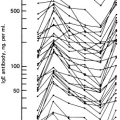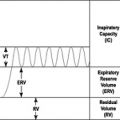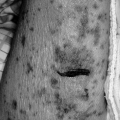Other Antiallergic Drugs: Cromolyn, Nedocromil, Antileukotrienes, Anticholinergics, and Theophylline
Carol A. Wiggins
There are many medications used in the treatment of allergic patients. Antihistamines, corticosteroids, and β agonists are discussed in Chapters 33, 35, and 34, respectively. A summary of drugs listed in 2007 National Heart, Lung, and Blood Institute/National Asthma Education and Prevention Program Expert Panel (NHLBI/NAEPP) report can be found in Table 36.1. Characteristics of other antiallergic drugs are cataloged in Table 36.2.
Table 36.1 Asthma Maintenance Drugs Listed in NHLBI/NAEPP 2007 Report | |||||||||||||||
|---|---|---|---|---|---|---|---|---|---|---|---|---|---|---|---|
| |||||||||||||||
Table 36.2 Characteristics of Other Antiallergic Drugs | ||||||||||||||||||||||||||||||||||||||||||||||||||||||||||||||||||||||
|---|---|---|---|---|---|---|---|---|---|---|---|---|---|---|---|---|---|---|---|---|---|---|---|---|---|---|---|---|---|---|---|---|---|---|---|---|---|---|---|---|---|---|---|---|---|---|---|---|---|---|---|---|---|---|---|---|---|---|---|---|---|---|---|---|---|---|---|---|---|---|
| ||||||||||||||||||||||||||||||||||||||||||||||||||||||||||||||||||||||
Cromolyn and Nedocromil
Cromolyn and nedocromil are chemically dissimilar drugs with similar pharmacologic and therapeutic properties. These drugs, collectively referred to as cromones, are nonsteroidal anti-inflammatory medications with no significant adverse effects. Roger Altounyan et al. developed the cromones as synthetic analogues of the herbal remedy khellin. Although often classified as mast cell stabilizing drugs, the cromones possess a number of anti-inflammatory properties. These drugs have generally been replaced by other anti-inflammatory drugs as first-line therapy, but may play a useful adjunctive role in the treatment of asthma, allergic rhinitis, and conjunctivitis.
Pharmacology
Cromolyn and nedocromil have low oral bioavailability, and all of their pharmacologic effects in asthma result from topical deposition in the lung. Cromolyn has a very short plasma half-life of 11 to 20 minutes (1). Nedocromil has a longer plasma half-life of 1.5 to 2 hours (2). There are no significant drug interactions with the cromones (1,2). Neither drug relieves bronchospasm; both should be used preventively, as maintenance medications or prior to exercise or allergen exposure.
Mechanism of Action
The cromones block chloride transport channels in airway epithelial cells, neurons, and mucosal mast cells that appear to result in their anti-inflammatory effects (3). Mast cell degranulation is dependent on calcium channel activation that is blocked by cromolyn and nedocromil. Chloride transport channels, which are blocked by the cromones, provide the negative membrane potential necessary to maintain calcium influx and the sustained intracellular calcium elevation necessary for mast cell degranulation, and allow for changes in cell tonicity and volume. The ability of the cromones to block chloride transport also may be the underlying mechanism for their other anti-inflammatory effects (4).
The cromones have been reported to inhibit release of mediators such as histamine, prostaglandin D2, and cytokines such as tumor necrosis factor-α from human mast cells (5,6). The cromones inhibit antigen- and anti–immunoglobulin E (IgE)-induced mast cell degranulation as well as mediator release triggered by calcium ionophore, phospholipase A, substance P, and compound 48/80 (1,5). Cromolyn inhibits mast cell degranulation in some tissue types better than others. Mediator release from human mast cells obtained from bronchoalveolar lavage is inhibited by much lower concentrations of cromolyn than is required to inhibit release from mast cells from human lung tissue
fragments. The cromones suppress eosinophil chemotaxis and decrease eosinophil survival (7). Cromolyn and nedocromil inhibit neutrophil activation and migration (8). The cromones also inhibit expression of adhesion molecules (9), as well as antigen-induced production of interleukin-5 (IL-5) from mast cells and mononuclear cells (9), granulocyte-macrophage colony-stimulating factor secretion (7), and IgE synthesis. (10,11).
fragments. The cromones suppress eosinophil chemotaxis and decrease eosinophil survival (7). Cromolyn and nedocromil inhibit neutrophil activation and migration (8). The cromones also inhibit expression of adhesion molecules (9), as well as antigen-induced production of interleukin-5 (IL-5) from mast cells and mononuclear cells (9), granulocyte-macrophage colony-stimulating factor secretion (7), and IgE synthesis. (10,11).
Challenge Studies
Inhalation challenge studies have determined that the cromones inhibit both the early and late asthmatic reactions when administered prior to allergen challenge. Nedocromil also inhibits the late phase of inflammation when administered after the onset of the early phase reaction (12). Cromolyn and nedocromil also inhibit bronchial hyperresponsiveness to other stimuli, including fog, exercise, cold air, and sulfur dioxide (13). The cromones do not inhibit bronchospasm induced by histamine or methacholine in the acute setting but may inhibit bronchial hyperresponsiveness to methacholine after several weeks of therapy (14).
Efficacy
Cromolyn and nedocromil have been reported to improve clinical outcomes and lung function when started early in the course of the asthma (15–17). They are effective in both nonallergic and allergic asthma. Although at least one study suggested that nedocromil is superior to cromolyn, most studies have reported no significant difference in efficacy. However, nedocromil may be effective when used on a twice a day schedule; this would tend to improve patient compliance compared with cromolyn, which must be used four times daily for optimal benefit (18).
The cromones are less efficacious than inhaled corticosteroids in the treatment of asthma (16). Some studies have suggested that the cromones have modest corticosteroid-sparing properties (19); others have failed to demonstrate significant steroid-sparing effects (20). Studies have demonstrated that cromolyn and nedocromil are similar in efficacy to theophylline, with significantly fewer side effects (21,22). Cromolyn is less effective than inhaled β agonists for prevention of exercise-induced asthma (23).
There is a common perception that nedocromil may be particularly useful when cough is a major asthma symptom, presumably by virtue of inhibitory effects on neuropeptides. However, cromolyn also inhibits the effects of inflammatory neuropeptides. Inhaled corticosteroids are effective in reducing asthmatic cough, and there is no evidence that nedocromil is superior to inhaled corticosteroids in suppressing cough as an asthma symptom. The cromones may be helpful in reducing cough associated with angiotensin-converting enzyme inhibitors when there is not an alternative to this class of drugs (24).
Current NAEPP guidelines suggest that the cromones may be used as alternative medications for patients with mild persistent asthma, or as prophylaxis prior to exercise or allergen exposure (25).
Safety and Drug Interactions
Cromolyn and nedocromil have no known drug interactions, toxicity, or clinically significant adverse effects. Cough or paradoxical bronchospasm may occur with inhalers. Some patients experience a bad taste with nedocromil. Both are pregnancy category B.
Dosing and Preparations
Cromolyn is available as a metered-dose inhaler that delivers 1 mg per actuation, and in 20-mg/2-mL ampoules for nebulization. The recommended dose of cromolyn is two inhalations, or one ampoule every 4 hours, or 10 to 60 minutes prior to exercise or allergen exposure.
Cromolyn is also available as a nasal spray for treatment of allergic rhinitis. It is less effective than topical nasal steroids and must be used 4 to 6 times daily for optimal benefit. Cromolyn and nedocromil are available as ophthalmic preparations for treatment of allergic and vernal conjunctivitis. Cromolyn is also available as a 100 mg ampoule to be taken orally for systemic mastocytosis and eosinophilic gastroenteritis.
Antileukotrienes
The leukotrienes, C4, D4, and E4, previously identified as “the slow reacting substance of anaphylaxis,” are known to be potent mediators of inflammation in asthma. Three antileukotriene drugs are available in the United States: zileuton, zafirlukast, and montelukast.
Leukotriene Formation and Biologic Activity of the Leukotrienes
The leukotrienes are formed from arachidonic acid. The initial steps in this process are catalyzed by an enzyme complex containing 5-lipoxygenase (5-LO). Separate pathways lead to production of leukotriene B4 (LTB4) or the cysteinyl leukotrienes: leukotriene C4 (LTC4), leukotriene D4 (LTD4), and leukotriene E4 (LTE4) (25).
The cysteinyl leukotrienes have a common receptor that is distinct from the LTB4 receptor. The cysteinyl leukotrienes are potent mediators of bronchoconstriction, airway responsiveness, micro vascular permeability, and mucus secretion. LTB4 is a well-recognized chemoattractant for neutrophils in the lung (25).
The leukotrienes are important mediators of aspirin-sensitive asthma. Aspirin-sensitive asthmatics have increased baseline levels of leukotrienes compared with nonaspirin-sensitive asthmatics, and develop markedly enhanced levels of leukotrienes in their lungs, nasal secretions, and urine following aspirin challenge (26). There are increased numbers of cysteine leukotriene receptor 1 in nasal biopsy samples from aspirin-intolerant patients with sinusitis.
Mechanism of Action of Antileukotrienes
The first antileukotriene to be approved was the 5-LO inhibitor zileuton. Zileuton directly inhibits the catalytic activity of 5-LO and inhibits production of LTB4




Stay updated, free articles. Join our Telegram channel

Full access? Get Clinical Tree








